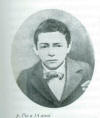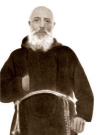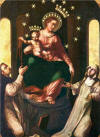A picture is worth a thousand words. As an introduction
to Padre Pio, the photographs will make us understand him better.
| |
 Padre Pio moved in the convent of St. Mary of Graces in San
Giovanni Rotondo in 1916. Padre Pio moved in the convent of St. Mary of Graces in San
Giovanni Rotondo in 1916.
He would stay there until his death in 1968. Note the wilderness.
|
| |
 Padre
Pio celebrated Mass at 5:00 AM. In the picture the men are standing
still, packed around the altar. The women are staying in the pews. To be
there on time, one had to get up at 3:00, and reach the church by 4:00,
to be able to find a spot when the doors opened at 4:30 AM. Padre
Pio celebrated Mass at 5:00 AM. In the picture the men are standing
still, packed around the altar. The women are staying in the pews. To be
there on time, one had to get up at 3:00, and reach the church by 4:00,
to be able to find a spot when the doors opened at 4:30 AM. |
| |
 This picture was taken in the 40's at 12:00 noon. This picture was taken in the 40's at 12:00 noon.
Padre Pio is at the window of the choir, above the entrance
to the church, praying the "Angelus" with the faithful.
|
| |
 Padre Pio wanted an hospital that would give
proper medical care for the poor peasants in the forgotten landscape in
the middle of nowhere were they lived, with no access to medical
facilities.
Padre Pio wanted an hospital that would give
proper medical care for the poor peasants in the forgotten landscape in
the middle of nowhere were they lived, with no access to medical
facilities. |
| |
 And he did it! He called it "Casa Sollievo della
Sofferenza" (Home for the Relief of Suffering."
And he did it! He called it "Casa Sollievo della
Sofferenza" (Home for the Relief of Suffering." |
| |
 This picture was taken the day that Padre Pio was proclaimed
saint on June 16, 2002. This picture was taken the day that Padre Pio was proclaimed
saint on June 16, 2002.
The old convent and church are on the side of the large church
of Santa Maria delle Grazie.
The window of the choir were Padre Pio prayed the "Angelus" and
waived to the crowd is still there.
|
| |

Here we are in Rome, the day that Padre Pio was proclaimed
blessed on May 2, 1999.
The number of pilgrims present at the ceremony is immense.
|
| |
 Padre Pio was proclaimed Saint on June 16, 2002
Padre Pio was proclaimed Saint on June 16, 2002
There is no other recollection of such a crowd packing Saint
Peter's Square.
|
| |
 Padre Pio' final resting place in the crypt with the gold
ceiling of San Pio's church. Padre Pio' final resting place in the crypt with the gold
ceiling of San Pio's church.
The body is in the pillar on the left, visible through an
opening.
There can be no better ending and beginning for a man who was
a gift of God to humanity for eternity.
|
| |
 It all started on Vico Storto Valle ("Crooked Valley Lane")
in Pietrelcina. It all started on Vico Storto Valle ("Crooked Valley Lane")
in Pietrelcina. |
| 1887 |
 Padre Pio was born in Pietrelcina,
a rural village few miles from Benevento, in Southern Italy.
Padre Pio was born in Pietrelcina,
a rural village few miles from Benevento, in Southern Italy. |
| |
 The village of about 3000 is located in a poor and
isolated region.
(It reminds of an episode in the Gospel: John 1: 45 "Philip found
Nathaniel and said to him, 'We have found him of whom Moses in the Law
and the prophets wrote, Jesus son of Joseph, from Nazareth.'
Nathanael said to him, 'From Nazareth?
Can anything good come from
that place?' Philip replied,
'Come and see.' ")
The village of about 3000 is located in a poor and
isolated region.
(It reminds of an episode in the Gospel: John 1: 45 "Philip found
Nathaniel and said to him, 'We have found him of whom Moses in the Law
and the prophets wrote, Jesus son of Joseph, from Nazareth.'
Nathanael said to him, 'From Nazareth?
Can anything good come from
that place?' Philip replied,
'Come and see.' ")
|
| |

 This is the birth certificate of Francesco Forgione.
It states that
the future Padre Pio was born on May 25,
1887,
at 5:00 PM. In a letter in 1922, Padre Pio wrote:
“The
Lord from my birth showed me signs of a very special predilection."
This is the birth certificate of Francesco Forgione.
It states that
the future Padre Pio was born on May 25,
1887,
at 5:00 PM. In a letter in 1922, Padre Pio wrote:
“The
Lord from my birth showed me signs of a very special predilection." |
| |
   He was baptized in the nearby Saint Anna's Church on May 26, 1887 the day after
his birth, and given the name of Francesco.
He was baptized in the nearby Saint Anna's Church on May 26, 1887 the day after
his birth, and given the name of Francesco.
|
| |
       The baptismal font were Francesco was baptized,
an the inside of the church of Sant'Anna. The last picture shows
the church as it was at the times of Padre Pio.
The baptismal font were Francesco was baptized,
an the inside of the church of Sant'Anna. The last picture shows
the church as it was at the times of Padre Pio. |
| |
  Padre Pio's crib preserved at the museum of
the Holy Family church in Pietrelcina
Padre Pio's crib preserved at the museum of
the Holy Family church in Pietrelcina
|
| |
 As he reported later, Padre Pio started seeing his
guardian angel since he was in the crib.
"The Guardian Angel has been my companion since my infancy."
He also stated seeing the devils:
"When I was in the crib, and my mom
extinguished
the oil lamp I saw those horrible monsters and screamed terrified. Than
mom turned the lamp back on, and the monsters disappeared, and I stopped
screaming."
As he reported later, Padre Pio started seeing his
guardian angel since he was in the crib.
"The Guardian Angel has been my companion since my infancy."
He also stated seeing the devils:
"When I was in the crib, and my mom
extinguished
the oil lamp I saw those horrible monsters and screamed terrified. Than
mom turned the lamp back on, and the monsters disappeared, and I stopped
screaming." |
| |
|
| |
  The name of Padre Pio’s father was Grazio, but he was known as
Orazio and called "Zi' Orazio" by his neighbors. The name of Padre Pio’s father was Grazio, but he was known as
Orazio and called "Zi' Orazio" by his neighbors.
The mother was Maria Giuseppa De Nunzio and was called "Zi' Beppa".
They married on June 8,
1881. Both were illiterate. He was a laborer.
They were not poor.
There
was food on the table every day. But there was very little cash. |
| |





 The house was located in Vico storto Valle, 32,
(Crooked Valley Lane)in Pietrelcina. It was a one room home. Like in the houses at the time: No plumbing. No bathroom. No running water. No
shower. No stove. No electricity.
The house was located in Vico storto Valle, 32,
(Crooked Valley Lane)in Pietrelcina. It was a one room home. Like in the houses at the time: No plumbing. No bathroom. No running water. No
shower. No stove. No electricity.
The
marble plaque outside the house tells that Francesco Forgione, the
future Padre Pio da Pietrelcina, was born in this house.


Under the house there was a storage room.

 
 Two doors on the left, they rented a two rooms
dwelling they called '"the kitchen". It was used for cooking, and had a
sleeping area for the children. Two doors on the left, they rented a two rooms
dwelling they called '"the kitchen". It was used for cooking, and had a
sleeping area for the children.
. |
| |
 The
Forgiones had 8 children. The first born was Michele. Then Francesco,
who died after 19 days, and Amalia who died at 20 months. When
Francesco, the future Padre Pio was born, he was given the name of the
older dead brother Francesco. He has also three younger sisters,
Felicita, Pellegrina, and Grazia (who was later to become a Bridgettine
nun). The youngest brother, Mario, died before he turned 1 year old. The
Forgiones had 8 children. The first born was Michele. Then Francesco,
who died after 19 days, and Amalia who died at 20 months. When
Francesco, the future Padre Pio was born, he was given the name of the
older dead brother Francesco. He has also three younger sisters,
Felicita, Pellegrina, and Grazia (who was later to become a Bridgettine
nun). The youngest brother, Mario, died before he turned 1 year old. |
| |
The farm "Masseria" in Piana Romana |
| |



_small1.jpg) _small1.jpg)




The Forgiones were farmers, cultivating their own piece of land,
in Piana Romana,
about an hour walk
away from Vico Storto Valle. The "Masseria" they owned in Piana Romana
was a one room dwelling. They went to work there, and stayed there during the busier
months. |
| |
 



In this space, outside the St. Anna's church Padre
Pio used to play in childhood with the other kids of his age. |
| 1892 |

A stained window in the church of Sant'Anna remembers
an episode of when the future Padre Pio was still in
preschool age, and later reported in a letter to his spiritual director, when he had the first apparition of
Jesus: "I felt like not playing with the other kids on the parvis,
and sat in a pew in the church, and Jesus from the tabernacle called me
to the altar and put his hand on my head".
At the time Francesco thought that this was normal to
everybody.
|
| |
 Teacher Angelo Caccavo.
Francesco had very limited formal schooling. There were no public schools in his
village. His first teacher was Cosimo Scocca, a farmer who had a fifth grade
education. His first grade teacher was Mandato Saginato. Starting September 1898, age 11,
he begun private lessons with
Domenico Tizzani, "per cinque lire al mese." The tuition of five lire per
month was quite a bit in those times. Padre Pio felt uncomfortable from day one, and after few months with don Tizzani, he changed
teacher.
He went to study with another teacher, Angelo Caccavo. With him Francesco got
the elementary diploma. A notebook with 30 themes developed by Padre Pio when he studied with Caccavo is
still preserved to these days.
Teacher Angelo Caccavo.
Francesco had very limited formal schooling. There were no public schools in his
village. His first teacher was Cosimo Scocca, a farmer who had a fifth grade
education. His first grade teacher was Mandato Saginato. Starting September 1898, age 11,
he begun private lessons with
Domenico Tizzani, "per cinque lire al mese." The tuition of five lire per
month was quite a bit in those times. Padre Pio felt uncomfortable from day one, and after few months with don Tizzani, he changed
teacher.
He went to study with another teacher, Angelo Caccavo. With him Francesco got
the elementary diploma. A notebook with 30 themes developed by Padre Pio when he studied with Caccavo is
still preserved to these days. |
| |
 Caccavo's desk preserved in the Museum in
Pietrelcina.
Caccavo's desk preserved in the Museum in
Pietrelcina. |
| |
 The desk of the shoe repair man Antonio Montella.
He had his shop near the home of Francesco. The future Padre Pio used to
stop by and chat with him.
The desk of the shoe repair man Antonio Montella.
He had his shop near the home of Francesco. The future Padre Pio used to
stop by and chat with him. |
| 1899 |
 This is the first known picture of Francesco Forgione, taken at age 12. This is the first known picture of Francesco Forgione, taken at age 12.
The future Padre Pio received the First Communion on 27 September 1899, at age 12,
in St. Anna's church, and was
confirmed the same day by the Archbishop of Benevento Mons. Donato Maria
Dell'Olio in the parish church of St. Mary of the Angels, in Pietrelcina. |
| |
 This is Fra' Camillo da Sant'Elia a Pianisi.
This is Fra' Camillo da Sant'Elia a Pianisi.
Fra' Camillo was a capuchin brother who walked the countryside away from
the convent to collect alms for the convent. Padre Pio saw him frequently in his childhood.
One day he told his mother:
"I want to be a friar with a beard, like fra' Camillo." |
| |
_small.jpg) Many times his mother found
Francesco sleeping on
the floor, using a stone as a pillow. Other times she found him
beating himself with a chain. Questioned about it he said: "I
must do like the roman soldiers beat Jesus and made his shoulders
bleed." Many times his mother found
Francesco sleeping on
the floor, using a stone as a pillow. Other times she found him
beating himself with a chain. Questioned about it he said: "I
must do like the roman soldiers beat Jesus and made his shoulders
bleed." |
| 1902 |
  In 1902
the future Padre Pio made a pilgrimage to Pompeii with his teacher Angelo Caccavo
and six schoolmates.
In 1902
the future Padre Pio made a pilgrimage to Pompeii with his teacher Angelo Caccavo
and six schoolmates.
“Soon I will enter the novitiate and there will be no more
parties.”
He also visited Sanctuary of the Blessed Virgin of Pompei when he was
military in Naples. He encouraged people to be
“devout of the Virgin of Pompei.” |
 Padre Pio moved in the convent of St. Mary of Graces in San
Giovanni Rotondo in 1916.
Padre Pio moved in the convent of St. Mary of Graces in San
Giovanni Rotondo in 1916.
 Padre
Pio celebrated Mass at 5:00 AM. In the picture the men are standing
still, packed around the altar. The women are staying in the pews. To be
there on time, one had to get up at 3:00, and reach the church by 4:00,
to be able to find a spot when the doors opened at 4:30 AM.
Padre
Pio celebrated Mass at 5:00 AM. In the picture the men are standing
still, packed around the altar. The women are staying in the pews. To be
there on time, one had to get up at 3:00, and reach the church by 4:00,
to be able to find a spot when the doors opened at 4:30 AM. This picture was taken in the 40's at 12:00 noon.
This picture was taken in the 40's at 12:00 noon.  Padre Pio wanted an hospital that would give
proper medical care for the poor peasants in the forgotten landscape in
the middle of nowhere were they lived, with no access to medical
facilities.
Padre Pio wanted an hospital that would give
proper medical care for the poor peasants in the forgotten landscape in
the middle of nowhere were they lived, with no access to medical
facilities. And he did it! He called it "Casa Sollievo della
Sofferenza" (Home for the Relief of Suffering."
And he did it! He called it "Casa Sollievo della
Sofferenza" (Home for the Relief of Suffering." This picture was taken the day that Padre Pio was proclaimed
saint on June 16, 2002.
This picture was taken the day that Padre Pio was proclaimed
saint on June 16, 2002. 
 Padre Pio was proclaimed Saint on June 16, 2002
Padre Pio was proclaimed Saint on June 16, 2002
![]() Padre Pio' final resting place in the crypt with the gold
ceiling of San Pio's church.
Padre Pio' final resting place in the crypt with the gold
ceiling of San Pio's church. 





























_small1.jpg)
_small1.jpg)












_small.jpg)




